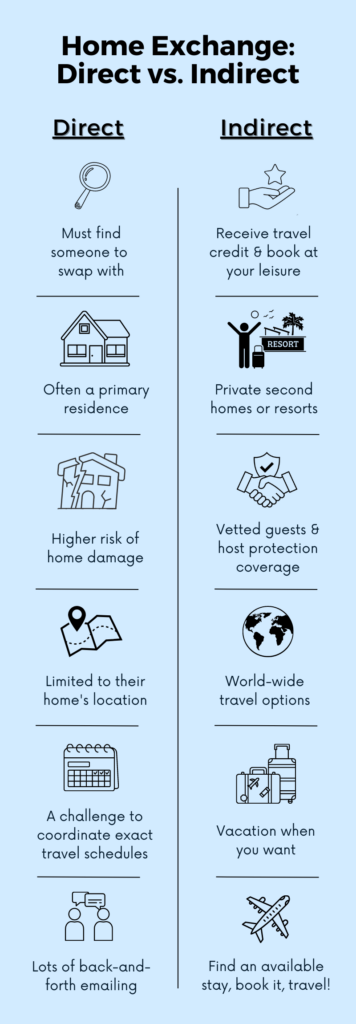
Direct vs. Indirect: Which Type of Home Exchange Is Right for You?
January 24, 2023 • By THIRDHOMEInterested in doing a home exchange? Many people find that home exchanges are the perfect way to explore the world safely and inexpensively. You get the same comforts of home for much less than you would pay for other accommodations like hotels. Swapping homes is relatively simple and quite exciting, but for first-timers, it may be overwhelming wondering where to begin. Luckily, this guide will explain the basics of each type of home exchange, such as direct and indirect, and how to choose the best option for you. Let’s get started!

What Does It Mean to Exchange Homes?
The name says it all. A home exchange or house swap is when two people temporarily exchange homes for a set period of time. Generally, both homes are located in different areas, be it different cities, states, or even countries. What’s more, is that the properties often vary in style. You might own a high-rise apartment in New York City or Chicago, whereas your exchange partner might have a beach house in Jamaica or a ski chalet in the mountains. The beauty of trading homes is that you never have to visit the same place twice.
What Types of Homes Are Eligible for Exchange?
If you were to search for a home exchange website, you’d find several different options. However, not all home exchange sites are created equal because there is more than one way to do a house swap. For starters, a house exchange can occur between homeowners’ primary residences or their second residences, such as vacation homes, investment properties, or fractional resort properties.
THIRDHOME’s exchange club, for example, is exclusive to luxury second homes rather than primary residences to ensure the best experience possible. Staying in someone’s primary home often feels intrusive and uncomfortable because they contain the owner’s personal belongings. What’s more, is that exchanging primary residences limits when and where you can travel. When you swap primary residences, both parties are bound to that property’s specific location.
A vacation home exchange, on the other hand, enables members to travel to more destinations and in more unique accommodations, such as yachts and five-star resorts. Not only can you swap your home for a stay in any destination of your choosing, but you’re also using your investment to your advantage. Rather than feeling guilty about your second property sitting empty, you can leverage it for additional and unique travel opportunities. It’s a win-win.

Understanding the Different Types of Home Swap Models
Direct Exchanges
Swapping primary residences translates to a direct exchange, which is where you simultaneously stay in somebody else’s home while they stay in yours. However, direct exchanges require you to find not only someone who wants to stay in your home but whose calendar and schedule also align with yours, which is especially challenging if you’re interested in a long-term swap. The direct exchange model doesn’t allow for flexibility of location or time frame and demands more advanced and extensive planning.
If you were to search for the perfect home swap match, it would take a lot of time and effort, including frequent correspondence. In fact, on average, 40 emails are exchanged between the guest and host members, which can be cumbersome.
Additionally, a direct home exchange may be difficult to arrange, depending on the location of your home. For example, someone with a penthouse in New York City might not be particularly interested in trading houses with someone in Oklahoma or Kansas. Consequently, direct exchanges tend to have a low rate of success.
Indirect Exchanges
An indirect exchange allows you to stay at another member’s home, even if they don’t stay in yours. The accommodating member receives an exchange credit to use as payment for their next exchange. This eliminates the need to coordinate schedules and allows maximum flexibility.
THIRDHOME, for example, uses the indirect exchange model by awarding Keys (credits) to members when they offer stays at their home. This, in turn, allows the member to use their Keys where and when they want without having to find another member who wants to use their home. As a result, members are able to make real-time bookings and plans without having to send speculative requests and wait for responses.
Best of all, THIRDHOME’s indirect exchange model is designed to work in tandem with conventional renting. Because our members choose which weeks they make available to other members of the Club, they are able to list any additional weeks on rental platforms, so they never need to worry about losing rental income.

Now that you’re familiar with the different types of home exchanges getting started is easy. To join THIRDHOME’s exchange club, simply qualify your home, browse our wide array of inventory, and begin traveling.
If you would like to learn more about our luxury home exchange opportunities, click here to browse our properties or visit our FAQ page.